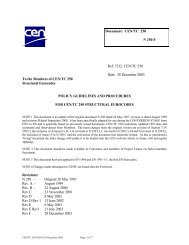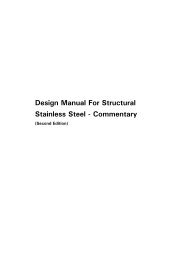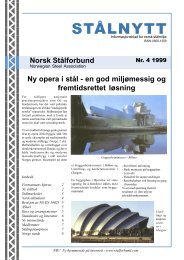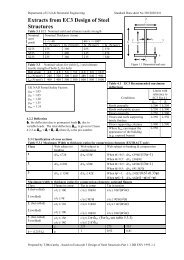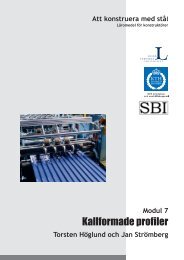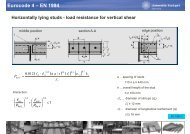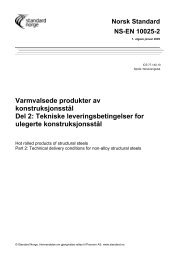<strong>Assessment</strong> <strong>of</strong> <strong>Existing</strong> <strong>Steel</strong> <strong>Structures</strong>, Remaining Fatigue Life First edition 2008Keyword in: EnglishGermanFrenchMild steel (19 th century)Flussstahl (19. Jhd.)Acier doux (19. siécle)Mild steel (20 th century)Flussstahl (20. Jhd.)Acier doux (20. siécle)<strong>Assessment</strong> spectrumBeurteilungsspektrumSpectre d’évaluationFatigue strength curveErmüdungsfestigkeitskurveCourbe de résistance à lafatigueDetail categoryKerbdetail, Kerbklasse,KerbfallCatégorie de détail1.6 General assessment procedureDefinitionLow-carbon steel produced by blast process (Bessemer or Thomasprocess) or hearth process (Siemens-Martin process), see section 3.4.Excess carbon and other impurities were oxidised from pig iron toproduce steel, which was normally un-killed (rimmed). In theBessemer process only low-phosphorus pig iron could be treated byacid lining <strong>of</strong> the converter whereas in the Thomas process also pigiron with a high content <strong>of</strong> phosphorus could be converted because <strong>of</strong>a basic <strong>of</strong> the converter. In the Siemens-Martin process pig iron couldbe melted together with steel scrap and/or iron ore. Metallurgicaltreatment was possible in the hearth furnace. Siemens-Martin steel hasa lower content <strong>of</strong> nitrogen than Bessemer or Thomas steel.Low-carbon low-alloyed steel produced in the end <strong>of</strong> the 19 th and thebeginning <strong>of</strong> the 20 th century using the Thomas or Siemens-Martinprocess. This kind <strong>of</strong> steel has properties close to those <strong>of</strong> modernmild steels (S235, S355), see section 3.4. Depending on the degree <strong>of</strong>deoxidation the steel can be un-killed (rimmed), semi-killed or killed.The total <strong>of</strong> all stress-range spectra in the remaining fatigue life <strong>of</strong> anassessed structure, which are relevant to the fatigue assessment.The quantitative relationship between the stress range and number <strong>of</strong>stress cycles to fatigue failure, used <strong>for</strong> the fatigue assessment <strong>of</strong> aparticular category <strong>of</strong> structural detail. The fatigue strengths given inthese recommendations are lower bound values based on theevaluation <strong>of</strong> fatigue tests with large scale test specimens.The numerical designation given to a particular detail <strong>for</strong> a givendirection <strong>of</strong> stress fluctuation, in order to indicate which fatiguestrength curve is applicable <strong>for</strong> the fatigue assessment. The detailcategory number in these recommendations indicate the referencefatigue strength Δσ c in N/mm² related to a specific endurance (2·10 6load cycles) as it is defined in Eurocode 3, Part 1-9, too.(1) The assessment <strong>of</strong> an existing structure aims at producing evidence that it will function safelyover a specified residual service life. It is mainly based on the results <strong>of</strong> assessing hazards andload effects to be anticipated in the future, and <strong>of</strong> assessing material properties and geometrytaking into account the present state <strong>of</strong> the structure [Lit. 8]. Guidelines <strong>for</strong> existing structuresexist in a large number <strong>of</strong> countries. Thereby many countries have presented documents <strong>for</strong>particular categories <strong>of</strong> structures. In Canada, Germany, the Netherlands, Switzerland, UKand USA such guidelines have been prepared at a detailed level. In any assessment, theproblem <strong>of</strong> fixing risk acceptance criteria is difficult since it must be compatible to codes <strong>for</strong>new structures (limit state analysis, safety factor <strong>for</strong>mat, etc.), and with national determinedparameters (generally partial safety factor values). The engineer has to think about riskacceptance criteria and is referred to section 1.7 <strong>for</strong> more in<strong>for</strong>mation.(2) The process <strong>of</strong> any structural assessment can be separated in the four phases, see Fig. 1-6 and<strong>for</strong> example [Lit. 8, Lit. 9, Lit. 124].8
<strong>Assessment</strong> <strong>of</strong> <strong>Existing</strong> <strong>Steel</strong> <strong>Structures</strong>, Remaining Fatigue Life First edition 2008Phase I Preliminary Evaluation: the aim is to remove existing doubts about safety <strong>of</strong> thestructure using fairly simple methods and identify critical parts or members in thestructure. This is per<strong>for</strong>med by gathering in<strong>for</strong>mation on the structure from drawingsand design computations, carrying out a site visit, etc. The assessment should be carriedout by the engineer alone. <strong>Assessment</strong> is per<strong>for</strong>med by using current codes and bymaking conservative assumptions where in<strong>for</strong>mation is lacking or doubtful.Phase II Detailed investigation: the aim is to update in<strong>for</strong>mation and to carry out refinedassessments only <strong>for</strong> those members where safety is not ensured. This is done by doingquantitative inspections (<strong>for</strong> example using easy to use, low tech NDT methods), the use<strong>of</strong> updated values <strong>for</strong> loads, resistance, as well as more accurate models (static system,structural behaviour). Here, in addition to the engineer, a specialised firm or agency orindividual experts are generally called in.Phase III Expert investigation: <strong>for</strong> problems with large consequences in terms <strong>of</strong> risks or <strong>of</strong> costsrelated to a decision, a team <strong>of</strong> experts should be called in order to check carefully theconclusions and proposals reached in Phase II. Discussions and further assessmentsusing specific tools (high tech NDT methods, probabilistic methods, fracture mechanics,etc.) can also be carried out to help in reaching decisions.Phase IV Remedial measures: the aim is to propose measures to have a fit <strong>for</strong> service structurewith sufficient safety. Different measures can be taken, among them one can mention:intensification <strong>of</strong> monitoring, reduction <strong>of</strong> loads or change in use, strengthening, repairor rehabilitation. The choice <strong>of</strong> the measures to be taken will be function <strong>of</strong> the structurestudied but in any case the pro<strong>of</strong> <strong>of</strong> adequacy <strong>of</strong> the measures to insure safety must beshown.(3) These phases will be further developed - with a focus on existing steel bridges and fatigue - inchapter 2.(4) The problem <strong>of</strong> existing bridges and <strong>of</strong> their assessment have recently increased. Indeed, thecurrent low funding in the infrastructure sector <strong>of</strong> many European countries <strong>for</strong>ces the ownersas well as the operators to postpone investments in new road and railway bridges andconsequently stretch the service life <strong>of</strong> their existing old structures. There<strong>for</strong>e, the owner <strong>of</strong>the infrastructure nowadays sees itself facing two main challenges: need <strong>of</strong> a furthercontinuing safe operation <strong>of</strong> the ageing bridges and <strong>of</strong> cost effective maintenance. Methodsmust be provided that enable engineers to <strong>of</strong>fer safe and cost effective assessment andmaintenance methods to their clients.9




